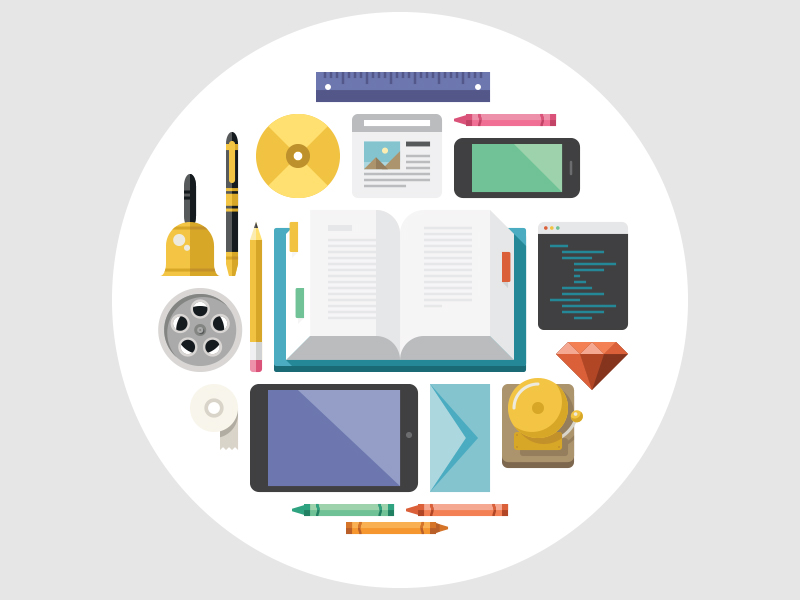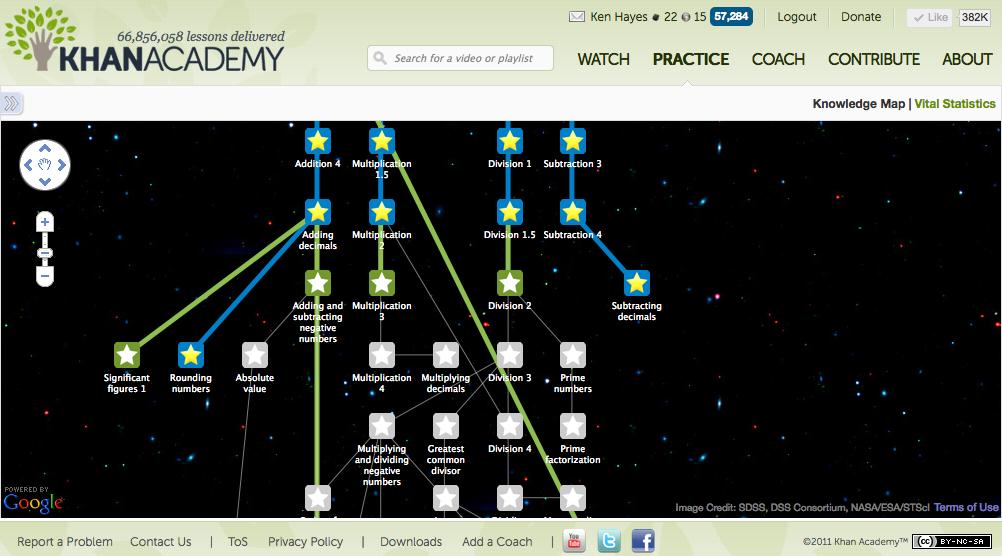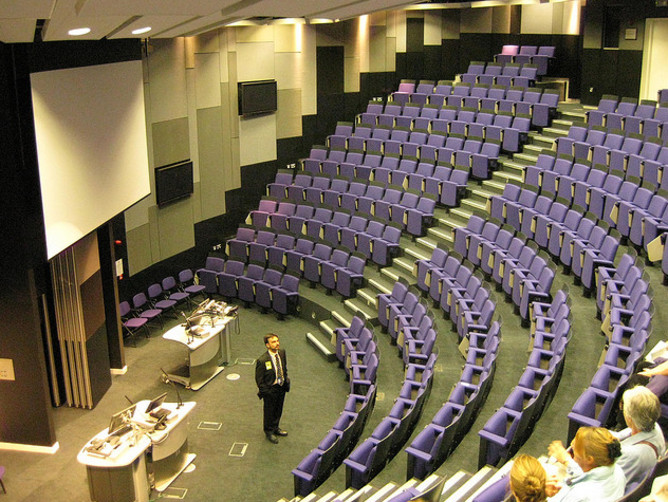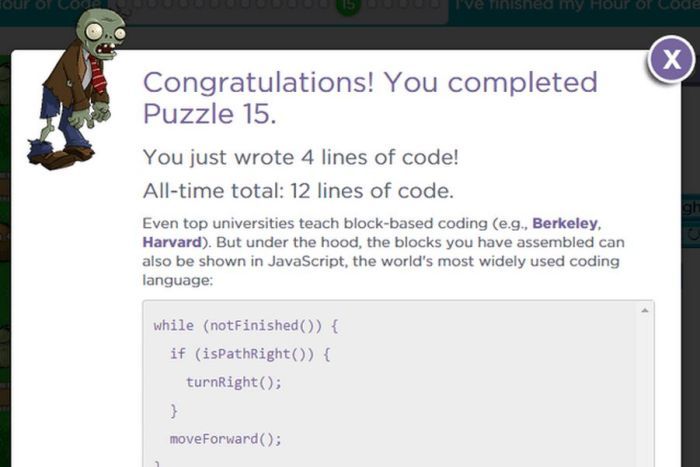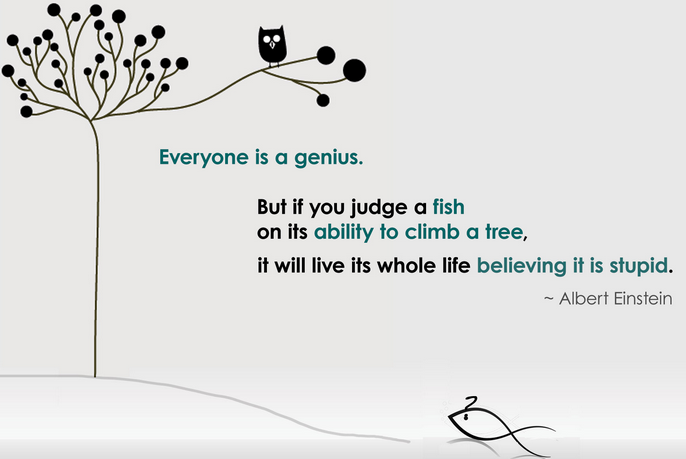4 Big Predictions For How Technology Will Disrupt Our Broken Education Industry
It won’t be news to most of you reading this that our education industry is one riddled with inequalitities and inefficiencies.
I’d go as far to say that it’s fundamentally broken.
I came across this amazing quote in an opinion piece on the state of the public education system:
“Students are segregated by age into “grades” where they are deprived of the chance to learn from older students, or teach younger ones.
Classrooms are rigidly organized into rows of desks. Students passively sit and listen to lectures long past the range of their attention spans. Back in the day, letting their minds wander off got kids a smack with a ruler; now they are drugged if they can’t sit still.
Everyone in the class moves through the curriculum at the same pace, graduating to the next grade if the standardized test shows they have absorbed at least 65 percent of the material, what we call ‘passing’. ” – Bill Frezza
What’s wrong with the education industry
The ‘one size fits all’ pedagogy is failing our students, particularly those who aren’t from well-off families or suburbs.
We are locked into an archaic education system (which has changed very little since it was first conceived in 19th century Prussia!) that is no match for our rapidly evolving digital world.
The rise of education technology, or ‘Ed Tech’, reflects the demand we are seeing from employers and society in general.
In Australia, there is a growing number of high school graduates who are not at adult levels of numeracy or literacy, who are poorly equipped to support themselves financially or contribute in a meaningful way to society.
And don’t even get me started on how schools crush creativity…check out this Ted Talk on the subject, it will blow your mind.
Granted, teaching styles have obviously evolved somewhat in the last few decades, recognising that collaborative, hands-on and multi-channel styles are a much more effective way of teaching than ROTE learning.
You know that old footage of children sitting at individual desks while they copy down and memorise spelling and arithmetic?
Yep, we’ve come a long way since then.
But there are still enormous leaps to be made, and education is in no way exempt from the impact technology is having on every industry.
Bonus: Hyperconnectivity: The Future Is Now
These are my predictions for the biggest technology trends to hit our education system in the next 50 years, and the challenges along the way.
Get ready, this is going to be big.
What Ed Tech means and doesn’t mean
Straight off the bat, let’s clear something up.
Bringing technology into the classroom and the curriculum is not about delivering information online.
That is, it’s not about using technology as an admin tool to support old systems of teaching – for example, giving students HTML links to content that normally would have been printed out.
That’s really not worth the billions of dollars in investment that Ed Tech mainstream adoption requires.
Instead, the real potential of Ed Tech lies in capturing, analysing and using data to overhaul inefficient teaching methods.
This data, at the student, classroom, school and various demographic levels, could pave the way for more personalised learning paths for students.
Customised learning through smarter technology would allow all students to learn at their own pace, totally disrupting the dinosaur ‘one size fits all’ approach to education we currently operate under.
It really makes little efficient sense to be treating all students in the same way just because they are of the same age.
Literatu is an Australian startup that makes data collection and analysis simple for educators, so they can craft more personalised content for each student.
It basically allows teacher to collect student responses and other data from interactive online activities.
Literatu’s interactive and instant data dashboards give teachers visibility and insights across all students. Data down to the question level is captured along with live monitoring capabilities that allow educators to see answers as they are being entered.
It’s an incredibly flexible tool that fits with what teachers are already doing. They have full control over course material, as well as how they would like to monitor student engagement and performance.
Added to that is the benefit of metrication at the end, so educators can spot trends and gain insights to propel future teaching methods.
4 Predictions For How Technology Will Disrupt The Education Industry
-
Many (not all) unis will close, online courses will rule
Learning after high school is, of course, important for ongoing professional development, not to mention personal mastery.
Recommended reading: 35 Game Changing Books To Guarantee Success In Your Startup Journey
However, the value of a university degree has steadily decreased over the last 30 years, with unemployment of university graduates at an all time high.
Bachelor degrees have become so ubiquitous that many employers value relevant work experience much more than where you went to university or what you studied.
In fact, a 2013 US study by the Center for College Affordability and Productivity found that nearly half of working Americans with college degrees are in jobs for which they’re overqualified.
If this is shocking to you, I’ve got news – we’ve been seeing this trends for years now.
It’s what has fuelled the rise of free, online courses like Khan Academy and Massive Open Online Courses (MOOC) like EdX.
Online learning through open courses is incredibly flexible, cost effective (or free) and more accessible than on-campus learning.
And in that regard, they are much more democratic than the university system, which has pretty serious barriers to entry for many socioeconomic demographics.
The rise in online courses comes at a time when the workforce is realising that the education system is fundamentally broken, and yet universities are becoming increasingly competitive to get into.
What’s most exciting about these classes offered through edX, for example (which are—and hopefully always will be—free) is that that they bring content from world class institutions like Harvard and MIT to the masses.
Democratising massive industries is one of the biggest impacts that technology can have on a society, and these courses are a prime example of that.
Bonus: How Fintech Startups Are Disrupting The Archaic Finance Industry
Will on-campus universities ever die out completely?
There are dozens of think pieces about whether free online courses will ever replace campus learning completely.
One day maybe, but I believe it’s unlikely that we’ll see a mass closing of bricks and mortar uni campuses any time soon.
1 main reason for this:
Old-school job interviewers currently don’t take them seriously as credits.
All you get after completing a free online course is a certificate of completion – nothing concrete and recognised.
A forward-thinking recruiter will understand that relevant job experience and skills are worth much more than a 4 year degree, and many already do. (I’m going to toot my own horn here and say I’m one of them).
But social norms are hard to break and the majority of businesses are slow to adopt this way of thinking.
A bachelor degree is a common prerequisite just to get in the door of many jobs, before you can even think of wowing the recruiter with work experience and extra-curriculars.
That being said, one thing that stands out above all else is that university alone, whether it’s online or not, doesn’t hold the credibility that it once did.
It’s a saturated market out there and graduates need a heck of a lot more than a piece of paper to get a job these days.
Real life experience is everything. And if you can’t get a job…then make one. Opting for self-employment above all else is the trend I’m keeping an eye on.
2. Programming will be taught in schools
I definitely wouldn’t say that everyone should be programmers in the future.
In fact, far from it. I think some people enjoy programming, and some people don’t – Just as some people enjoying making things with their hands, or selling, while others don’t.
BUT moving into the 22nd century where EVERYTHING is made of software or from software it’s imperative that people have a ‘general’ understanding of how programming works.
Australia struggles to compete on innovation next to the Singapores and Silicon Valleys of the world, and a big part of that is down to poor foundations.
Australia has a dire shortage of technical talent and engineers.
In fact, hiring talent was one of the most frequently reported challenges of Aussie startups in 2014.
It’s been proposed that to foster a culture of innovation and tech startups in Australia we need to start teaching kids these technical skills early.
According to the Australian, 21st century computer coding will be taught in primary schools from Year 5, and programming will be taught from Year 7 as part of the new national curriculum.
This has definitely been a long time coming, and reflects new PM Malcolm Turnbull’s focus on boosting the Australian economy through technological innovation.
Recommended Reading: Why Malcolm Turnbull Is The Best Excuse To Build A Startup In 2015
Making coding compulsory in schools from an early age will go a long way toward addressing the shortage of technical skills in the workforce, and the relatively low number of Maths and Science graduates.
One startup making coding engaging for students is Code School.
Code School offers an alternative way of ‘learning code by doing’: Students watch a short lesson in video form, and are progressively asked to complete interactive tasks in the browser to test the knowledge they’ve just learned.
They must complete the challenge before they can progress to the next video, and are regularly rewarded with badges and a point-based system to gamify the experience.
It’s even supported by a mobile app to complement the online course, so students can review videos on the go.
It’s these kinds of multi-channel, immersive and ‘practice over theory’ courses that will become commonplace in schools.
They’ve been proven again and again to be the most effective ways of getting students to understand new information.
3. Schools will operate less like factories, and more like colleges
To say that public schools have budgetary restrictions is an understatement – they never have enough money!
Tim Brady, founder of EdTech incubator ImagineK12, predicts that in 10-15 years we will see a massive shift in the processes that have ruled schools for the last 2 centuries.
“High schools, and maybe even middle schools, will begin to operate less like factories and more like colleges.” – Tim Brady
Age-based segregation will be replaced by competency-based segregation, promoting greater customisation in education.
This pivot in the business model will be driven by improved capabilities of learning software – that is, technology that learns from inputs and adapts to the individual student’s need.
Of course the challenge here is that the current schooling system assumes that if you’re not working at the same level as other students of your age then you must be stupid.
Instead we need to operate on the understanding that everyone has strengths and weaknesses. Schools need to help kids identify and amplify their strengths.
Junyo is a company that builds customised technology solutions to help districts and schools collect and analyse data for learning enhancements.
Their flagship product is Streams, a classroom tool-set that provides personalized instruction to close skill gaps and accelerate achievement for the whole class, small groups and individual students.
Access to low-cost technology like this will accelerate wide-spread adoption and allow for this kind of ‘self-paced’ learning to become a viable alternative to traditional, rigid methods.
Tech giants are also getting on the Ed Tech train.
IBM has come up with advanced learning technology solutions known as PETALS (Personalized Education Through Analytics on Learning Systems) that use predictive modeling, advanced case management, machine learning and deep content analytics.
Heavy stuff.
4. Much more in-depth teacher training

Teachers need to be taught how to handle this new technology appropriately.
Currently, teachers are not being given enough instruction on how to teach STEM subjects during their initial teacher training.
In fact, a controversial OECD study that came out in September 2015 found that students who use computers every day at school had lower reading and maths scores than those that used computers less often.
This didn’t translate across home use of computers, just classroom use.
These are pretty sobering findings, with the same study finding that schools with fewer computers saw larger educational gains from technology than those with more devices per student.
Moral of the story? Teacher training is not keeping pace with technology.
As well as being taught how to use the technology they are integrating into the curriculum, teachers need to know how to analyse real-time performance data from students so that their instruction can be modified and tailored to each student.
It’s this customisation that holds the real potential of technology, not in just throwing in a computer and hoping a student remembers what they’ve copied and pasted from Google!
Another trend that is growing in the workforce is the ability to read and draw insights from data. This comes as no surprise with the increase in data capture.
Did you know that 90% of data was captured in the last 2 years? Analyse that trend for a minute…
“Lots of technological investments are not translating into immediate achievement increases. If raising student achievement was as easy as giving every student a device, we would have this solved. It’s not easy.” – Bruce Friend, COO of iNACOL
Key challenges moving forward
- Making technology just for technology’s sake
There are many educational apps on the market that are ineffective.
The reason for this is because they weren’t built for their target user – they don’t ask teachers what they want, and respond to that feedback by building a solution that solves a need!
Solving your customer segment’s pain points is the first step to validating your app idea, and many Ed Tech apps get this wrong.
No matter how exciting the technology is, it must be supportive of a primary need or goal that the teacher, student or educator is seeking to fulfill.
“The most successful designers of education technology will keep the end in mind, rather than pushing tech innovations for technology’s own sake.” – Aaron Skonnard
2. Scalability
The scalability of ed tech solutions isn’t just an advantage, it’s a necessity.
Technology has a way of integrating into education only once it its integration becomes affordable and practical.
I’ve already talked about how tight the public education budget is, and this only strengthens the need for Ed Tech software to be scalable, intuitive to use, and not too hardware intensive.
Cloud based solutions and ones that support the current Bring Your Own Device movement we’re currently seeing in the corporate and education sector alike, will be essential moving forward.
3. Overcoming public backlash
As is always the case when introducing disruptive technology to a stagnant, giant industry, there is some resistance that Ed Tech startups face.
Sal Khan, for example, has gone to pains to stress that Khan Academy is a friend to the traditional school classroom teacher, not a replacement. He is clearly wary of the backlash that his company may face from teachers unions.
Striking the right balance between classroom instruction from teachers and from machines is crucial to gaining public understanding of the role technology plays in supporting our teachers.
“Artificial intelligence isn’t yet good enough to replace teachers entirely, but software can take care of the more menial parts of one-on-one instruction, leaving educators free to plan lessons, assess their students and focus more on the cognitive part of education that is so often accused of being overlooked at the expense of rote memorization.” – Lingo Media
By the way, make sure you check out this groundbreaking product demo video below from artificial intelligence company Magic Leap – It’s as real as artificial intelligence has ever looked.
They reckon that the primary application of this technology will be in schools.
Final food for thought
I’m pretty passionate about the future of education in Australia, and I’m excited to see how technology will solve some of these gaping, expensive structural problems in the industry.
It’s going to take a lot of investment, policy reform and ongoing support, but I believe it’s an essential step for ensuring future generations are equipped to tackle the world’s biggest issues.
“We will fail fewer students because they will be more engaged, and we will lose fewer teachers to frustration. And that is an investment worth making.” – Tim Brady
Do you agree with my predictions? Let me know your thoughts in the comments!
Where to go next
5 Revolutionary Tech Projects Making The World A Better Place
5 Exciting Predictions For The Future Of Collaborative Consumption
5 New Technologies Disrupting The Retail Industry
Why Mobile Health Tech Is So Much More Than A Fitness App
Latest posts by Logan Merrick (see all)
- Ep 18: Collective Campus’ CEO on Intrapreneurship and Corporate Innovation - December 20, 2016
- 50 User Engagement Strategies For Planning Memorable Mobile Experiences - December 19, 2016
- Latest Data: App Monetisation Trends And Drivers 2015-2020 - November 25, 2016


